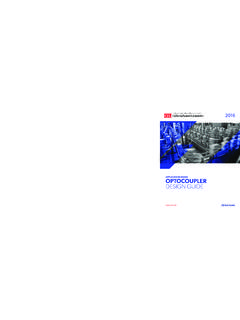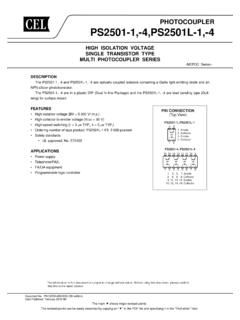Transcription of Designing and Characterizing TRL Fixture Calibration ...
1 Designing and Characterizing TRLF ixture Calibration standards forDevice ModelingBy Julien Fleury and Olivier BernardCalifornia Eastern LaboratoriesTo measure and characterizedevices, California EasternLaboratories (CEL) uses dif-ferent fixtures and calibrationmethods. One is the through-reflect-line, or TRL, which can beused to calibrate the HP8510 net-work analyzer. Like other Calibration methods,the TRL introduces a 12-term errorcorrection vector for each frequen-cy point. To calculate these terms, standards for which S-parameters are knownmust be measured.
2 These standards include ashort order open a through and a delay line withknown electrical delay. The TRL Calibration cor-rects phase and magnitude errors introduced bythe sliding of reference planes and the insertionloss of cables, fixtures and connectors. Precisioncalibration standards should be used becauseeach defect in a standard will be transformedinto Calibration application note explains how to charac-terize and build a proficient TRL Calibration kitfor the HP8510 Network Analyzer. The firstpart explains how to characterize a TRL cali-bration kit.
3 The second part describes how toimprove the Calibration kit using the measure-ments made on it. First, the TRL is described inmore of a network analyzerIn any measurement, systematic errorsources change the response of a device undertest (DUT). Annuling the effects of cables, con-nectors, mismatched lines and couplers requiresa Calibration that provides correction term vec-tors for each frequency point. With multiple fre-quency points, this vector becomes a popular correction vectors are the eight-term and 12-term correction 12-term error correctionTwelve-term error correction permits thecorrection of six terms in forward and six inreverse mode.
4 These six terms are: ED, the directivity term ER, the reflection tracking term EL, the load match term ET, the transmission tracking term ES, the source match term EX, the isolation termThese are seen in the flow graph (Figure 1),which represents the forward error terms. This correction is the most efficient, is avail-able on high quality network analyzers and it cor-rects all systematic errors provided by the net-work analyzer. The eight-term Calibration is oftenused in less expensive network analyzers. It issimpler but does not correct all the systematicerrors, such as the errors introduced whenswitching to an alternate measurement APPLIEDMICROWAVE& WIRELESS Figure 1.
5 Flow graph of the forward path 12-term error APPLIEDMICROWAVE& WIRELESSThe eight-term error correctionThe eight-term error correction models are eachaccessed by a quadripole defined by its are four terms per port and two ports. In somenetwork analyzers, isolation is corrected also, which isnot included in the eight-term correction. This kind ofcorrection can be modeled by the flow graph (Figure 2).The TRL calibrationThe TRL Calibration uses the through, the delay lineand a reflection standard, either an open or a of the four S-parameters is calculated for eachstandard.
6 That means that 12 parameters are a system of equations, it is then possible tofind 10 of the 12 error terms. The two missingterms are the forward and reverse isolation termswhich can not be extracted from that set of equa-tions. If the user wants to calibrate these parame-ters, isolation Calibration with two loads (as in theOSLT Calibration ) is flow graph of each TRL standard is shown inFigure of a TRL Calibration kitErrors sourcesErrors appear when the standard used for thecalibration is different from the Fixture of the deviceunder test.
7 For example, if the Fixture strip does nothave the same board thickness as the through stan-dard, its frequency response will not be the same asthe standard. The systematic error will not be thesame as the standard and the correction will notremove this error. The difference between thisstandard and the Fixture strip response will beadded to the component response, biasing theresults. Therefore, one critical factor when buildinga Calibration kit is the repeatability of each stan-dard and test Fixture . Each standard must only dif-fer by that aspect of the electrical characteristicwhich was intended to change.
8 For example theonly desirable difference between a through and a delayline is the phase. All other parameters (including inser-tion loss) should be identical. In practices this is impos-sible, but differences should be minimized. Differencesbetween standards and fixtures are numerous. Thebiggest difference is often the assembly of the connectorbecause it is a human process. Other variables, such asstrip thickness, are negligible because processes arerepeatable. Therefore, it is very important to test eachconnector and measure each return loss.
9 These mea-surements can be done in the time domain as explainedin the Time domain standards are not perfect, they are an errorsource. The network analyzer assumes that standardsare perfect during the Calibration . For example, thereflect standard does not have a reflection coefficientequal to one (see Figure 4). Some of the incident signalradiates. The higher the frequency, the greater the radi-ation. The correction vector becomes less and less pre-cise as the frequency increases. The imperfect aspect ofthe open can be modeled with a frequency dependentnonlinear capacitance and return loss in the calibrationkit definition of the HP8510 network modeling and implementation on the HP8510is explained in the Modeling standard good Calibration kit standard can provide poorresults if it is not well implemented in the HP8510.
10 Theelectrical delay of each delay line should be measured Figure 2. Flow graph of the eight-term error correction. Figure 3. Flow graphs of TRL : dBMagFreq : GHzS22 : dBMag Perfect Real Figure 4. Response of a reflect line (S22).30 APPLIEDMICROWAVE& WIRELESS with good precision. If the delay is not the same as theparameter implemented in the HP8510, there is a linearfrequency dependant systematic phase error (see Figure5). The measurement of delay lines is a substantial partof the Calibration difference between a perfect open, a perfectthrough and a perfect line can be defined on the Smithchart by a phase shifting.
















